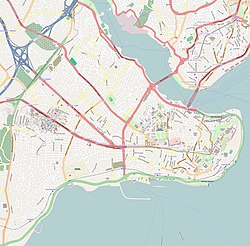world.wikisort.org - Turkey
Yedikule (English: Seven Towers) is a neighborhood of Fatih, Istanbul in Turkey. It is named after the seven-towered Yedikule Fortress, which surrounds the neighborhood. Urbanized in the 16th century, the neighborhood became a hub for industrial and agricultural activities. Yedikule has a local football team Yedikule GSK that played in the TFF Second League for a season.[1]
Yedikule | |
|---|---|
Neighbourhood | |
 Aerial photograph of Yedikule Fortress (lower half of the image) and Fatih | |
| Coordinates: 40.9933525°N 28.923093°E | |
| Country | |
| Province | Istanbul |
| District | Fatih |
| Time zone | GMT +2 |
| Area code | (+90) 212 |
Marmaray passes through the neighbourhood, however Yedikule railway station is closed and the trains do not serve to the neighbourhood.
History
Urbanization of Yedikule started in 16th century, and became a major hub for industrial and agricultural activities.[2] Yedikule Walls (also known as Theodosius Walls) are also an notable historical artifact. Its tower, Yedikule Fortress, constructed between 408-450 AD, and repaired after 740 Istanbul earthquake.[3]
Ottoman period
Yedikule was known with its gardens, Yedikule Urban Gardens, which was also famous with its cabbages and lettuces and used more than 1500 years.[4] According to the guarantor books of year 1735, there were 344 gardens (including nine gardens which is established between "Surdibi" area, which stretch between Yedikule Gate and Silivri Gate); according to a map from 1835, there were 102 gardens.[4]
Yedikule (with Edirnekapı) was also became host for some establishments like slaughterhouses, soap and candle makers, and workshops.[2]
Modern times
Yedikule became highly populated after the population boom in Istanbul between 1940s-1980s; and as a result of that, the Urban Gardens and industrial areas became residential areas and some parts of Urban Gardens used for build Otoyol 1 and create waste-filling areas in 1970s. The municipality of İstanbul started a rehabilitation project for remaining parts of Urban Gardens.[5] Ekrem İmamoğlu, as the Mayor of Istanbul, stated that: "I'm ashamed from that the walls (Yedikule Walls) hasn't been toured since years."[6]
Soil and seismology
A major seismically active fault zone, the North Anatolian Fault, passes offshore from Yedikule in the Sea of Marmara.[7]
Demographics
Yedikule was including a notable non-Muslim population and schools until the recent times. There is also Greek and Armenian churches and an Armenian hospital, Yedikule Surp Pıgiç Hospital.[8] Its population is 18,879 according to 2019 census.[9]
In popular culture
Kazım Koyuncu gave a concert in Yedikule Fortress in 2004.[10] Yedikule also hosted thematic festivals such as Lettuce Feast (Turkish: Marul Bayramı) in the past.[5]
Gallery
 The Yedikule Fortress ("Fortress of the Seven Towers") and the Golden Gate in Istanbul by Fr. Scarella c. 1685
The Yedikule Fortress ("Fortress of the Seven Towers") and the Golden Gate in Istanbul by Fr. Scarella c. 1685- Yedikule from the Marmara Sea, late 19th century
- The Fortress in 2008
References
- "Mahallî Ligin umumi bilançosu". Cumhuriyet. 16 June 1961. p. 6.
- Akyazıcı Özkoçak, Selma (2003). "Two urban districts in early modern Istanbul: Edirnekapı and Yedikule". Urban History. 30 (1): 26–43. doi:10.1017/S0963926803001020. ISSN 0963-9268. JSTOR 44598521. S2CID 145545146. Retrieved 9 January 2021.
- Acun Özgünler, Seden; Ersen, Ahmet; Güleç, Ahmet (1 December 2010). "Yedikule Kara Surları'nda Kullanılan Erken Bizans Dönemi Harçlarının Karakterizasyonu Üzerine Bir Araştırma". Restorasyon ve Konservasyon Çalışmaları Dergisi (in Turkish) (5): 31–39. ISSN 1309-7016. Retrieved 9 January 2021.
- Kanbak, Ayşegül (2016). "İstanbul Yedikule bostanları: Bir yerinden üretim pratiği". ISSN 2147-4877. Retrieved 9 January 2021.
{{cite journal}}: Cite journal requires|journal=(help) - Durusoy, Elifnaz (2016). "Historic Landscape vs. Urban Commodity?: The Case of Yedikule Urban Gardens, Istanbul". MEGARON / Yıldız Technical University, Faculty of Architecture e-Journal. doi:10.5505/MEGARON.2016.48343. Retrieved 9 January 2021.
- "BAŞKAN İMAMOĞLU'NDAN "TARİHİ SURLAR" YORUMU: "SURLARIN YILLARDIR GEZİLMEMESİNDEN UTANIYORUM"". www.ibb.istanbul. Retrieved 10 January 2021.
- Keskinsezer, Ayhan; Beyhan, Günay; Gallajov, Javid (8 August 2019). "Investigation of the soil structure of the area between Yedikule to Sirkeci (İstanbul) using PS logging and earthquake data". Russian Journal of Earth Sciences. 19 (4): 1–12. doi:10.2205/2019ES000668. Retrieved 9 January 2021.
- Kalkan, Ersin (2002). 168 yıllık sağlık abidesi: Yedikule Surp Pıgiç Hastanesi'nin tarihi yazıldı.
- "YEDİKULE MAHALLESİ NÜFUSU, FATİH İSTANBUL". www.nufusune.com. Retrieved 10 January 2021.
- Solomon, Thomas (2017). "Who Are the Laz? Cultural Identity and the Musical Public Sphere on the Turkish Black Sea Coast". The World of Music. 6 (2): 83–113. ISSN 0043-8774. JSTOR 44841947. Retrieved 10 January 2021.
Другой контент может иметь иную лицензию. Перед использованием материалов сайта WikiSort.org внимательно изучите правила лицензирования конкретных элементов наполнения сайта.
WikiSort.org - проект по пересортировке и дополнению контента Википедии



